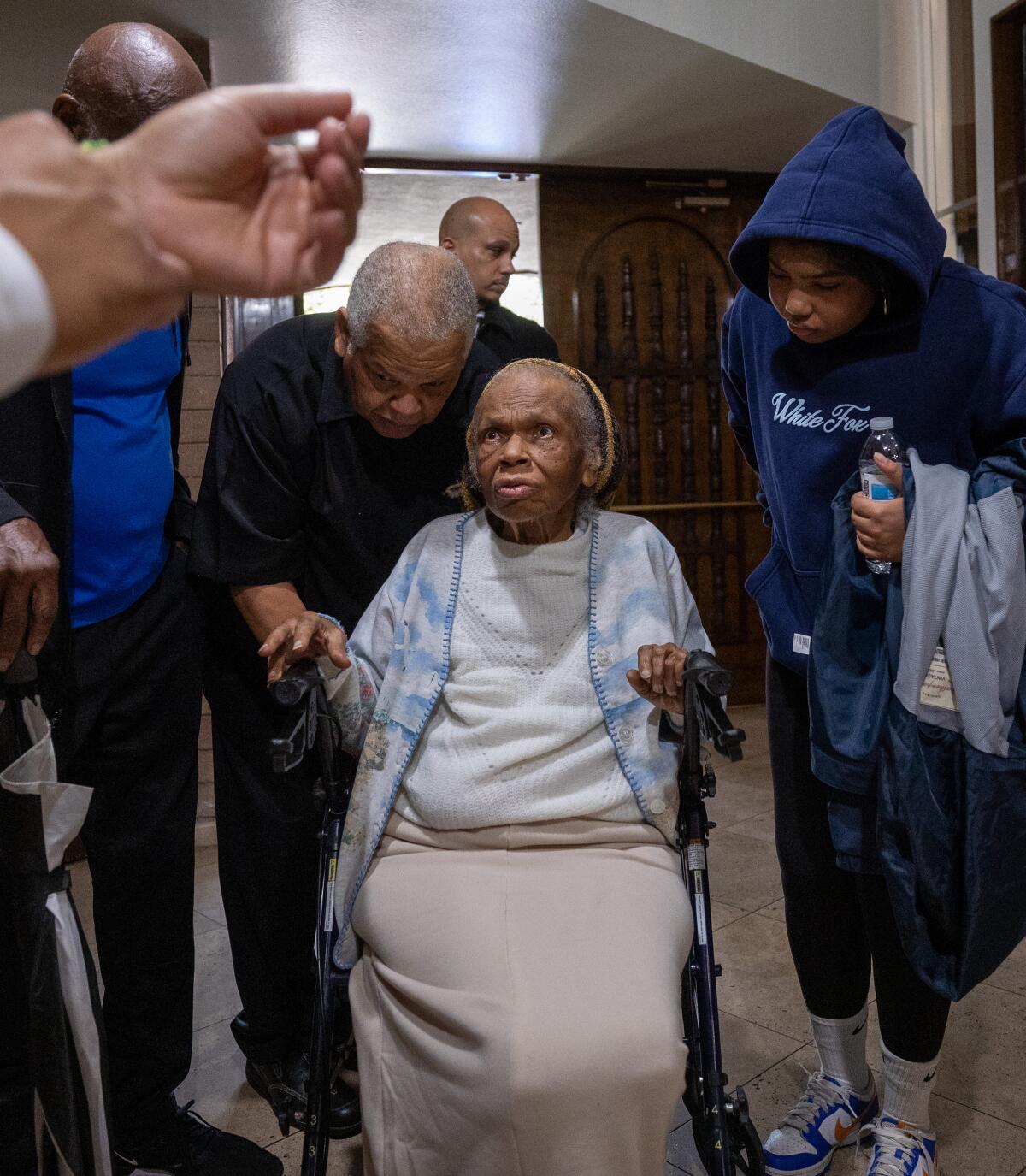Donations topped $650 million, and the question looms: How to best use it for fire recovery?

- Share via
When wildfires swept through Los Angeles, people and corporations from around the world responded by opening their wallets in a way that broke records for generosity.
Money poured into thousands of different recipients, from venerable nonprofits such as the United Way and Habitat for Humanity, to individual families through GoFundMe, to specialized groups working to replace burned musical instruments and stuffed animals.
The array of organizations makes a precise tally of the philanthropic dollars challenging, but the amount raised and pledged over the past month is well in excess of $650 million, according to interviews with nonprofit executives and publicly announced fundraising efforts.
That appears to set a fundraising record for wildfires and exceeds giving for recent natural disasters. Charitable contributions for Maui’s deadly 2023 fire totaled about $450 million, according to a database compiled by Honolulu Civil Beat. Fundraising for Hurricanes Milton and Helene, which devastated the southeastern U.S. last year, topped $278 million, according a partial tabulation by the philanthropy site Candid.

The charitable outpouring for the January fires reflects the scale of destruction in the Palisades and the Altadena area, the connection people far from California feel to L.A. and Hollywood, and celebrities’ place as both survivors and fundraisers.
Walt Disney, Warner Bros. Discovery, Netflix and Comcast, are steering tens of millions of dollars to disaster relief and recovery efforts.
Musicians on the Feb. 2 Grammy Awards broadcast appealed for donations. Billie Eilish, Stevie Wonder, Red Hot Chili Peppers and others performed at the FireAid benefit concert last week. Together, organizers estimate, they will bring in more than $125 million.
How will all this money be spent?
Hundreds of millions of dollars already have. Online fund drives through GoFundMe put more than $200 million in the hands of families and individuals who lost homes and livelihoods and related causes, according to company data.
Many nonprofits also quickly converted contributions into cash for evacuees and others affected by the fires.
“I was literally driving around L.A. with stacks of checks,” said Wade Trimmer, the president of the Change Reaction, a Sherman Oaks-based charity that distributed about $5 million in direct assistance. Trimmer said faith-based and community groups identified more than 2,300 people to receive grants of between $1,500 and $2,500.

About 80% of recipients in the Pasadena area were elderly, he said, adding, “We had people at our events who were coming up to us and saying, ‘I am going to use this gift card right away because I need food tonight.’ ”
The L.A. Regional Food Bank, which has collected $5 million, set up distribution sites in East L.A., Irwindale and elsewhere and expanded its operations from six to seven days a week.
In the aftermath of the Eaton and Palisades fires, several companies with ties to Southern California have donated millions to relief efforts.
“We’ve been operating pretty much every day and longer days to be able to deal with increased volume,” said food bank Chief Executive Michael Flood. Sometimes, he said, “the late shift met the first shift coming in the next day.”
Just two days after the fires, a group of nonprofits established the Dena Relief Drive to distribute emergency supplies: shoes, clothing, laptops for students whose computers burned in the fires and gift cards totaling $80,000 to pay for groceries, lodging and a host of unanticipated expenses facing people who lost their homes.
“We had a few families that had children with eczema, and they needed a certain kind of lotion, and we were able to give out gift cards for that,” said organizer Brandon Lamar.
The California Community Foundation helped underwrite the effort. The philanthropic giant raised $60 million in the month after the fire and will have distributed half that by next week, the organization said.
The foundation gave $100,000 to 11 places of worship destroyed by the fires, including St. Mark’s Episcopal Church in Altadena. The Eaton fire ripped through its school and church campus, burning nine buildings, and at least 40 members lost their homes.
“It was sort of breathtaking,” said the Rev. Carri Patterson Grindon of receiving the grant. The church has earmarked the money for members struggling with day-to-day expenses and beyond that for kick-starting reconstruction. “It’s our intention to rebuild. We just don’t know what that will look like yet.”
Even with the funds spent on immediate relief, a vast amount of charity money remains. Nonprofit executives have been meeting to discuss when and how to shift to mid-term and long-term recovery efforts.
A month after the fires, about 300 people were still in a Red Cross shelter in Pasadena, a number some in the philanthropic community are watching as a metric, said Lily Bui, who has been tracking fundraising at 20 established foundations for the nonprofit SoCal Grantmakers.
“Once that number reaches zero, then we can meaningfully talk about recovery,” Bui said.
The Getty, LACMA, MOCA and Hammer museums have partnered with George Lucas’ and Steven Spielberg’s foundations and other groups to create the L.A. Arts Fire Relief Fund.
In the meantime, charity officers have been hearing from people experienced in rebuilding after natural disasters. One is Jennifer Gray Thompson, whose nonprofit After the Fire USA has advised Maui, Paradise and other communities upended by wildfires on navigating the rebuilding process.
“We want them to plan, really, for seven years of funding,” said Thompson, adding that she encouraged foundations to see recovery as “a marathon of sprints” and to hold onto enough money to help long term. “You can’t really start up a program for an unprecedented disaster, and expect it to fulfill its outcomes in a year.”

Charitable spending will play out alongside an influx of other money for rebuilding: billions of dollars in expected federal aid, individual insurance settlements and potential payouts from a myriad of lawsuits.
Even within the philanthropic community, the landscape could be complex. Long-standing local foundations and new initiatives, such as those launched by local billionaires Rick Caruso and Evan Spiegel, are figuring out how to deploy their resources.
In Maui, major foundations set up a collaborative to give out money, but there is no current plan for a charity czar or committee in L.A.
“I think there’s a lot of effort to share what folks are doing … so that duplication can be avoided,” said Jennifer DeVoll, president of the Pasadena Community Foundation.
Early discussions on how to spend the money have included mental health services for first responders and survivors, training displaced workers for construction jobs, grants for the underinsured and land trusts to discourage speculators.
Several nonprofit executives said that, in a disaster that affected people of all socioeconomic levels, charitable funds were best spent on the poor and marginalized.
“The systems of recovery are designed for folks who have the ability to navigate a very complicated system. They are not designed for the most vulnerable,” said Miguel Santana, chief executive of the California Community Foundation who is also part of Spiegel’s venture, Department of Angels.
A disaster case management system that will gather extensive information about the specific situations of thousands of families and individuals is expected to ramp up in coming months and provide additional insight to philanthropic institutions.
“That is what all of the nonprofits are going to be champing at the bit to know,” said Jenni Campbell, executive director of the L.A. Region Community Recovery Organization. “What are the unmet needs?”
More to Read
Sign up for Essential California
The most important California stories and recommendations in your inbox every morning.
You may occasionally receive promotional content from the Los Angeles Times.













